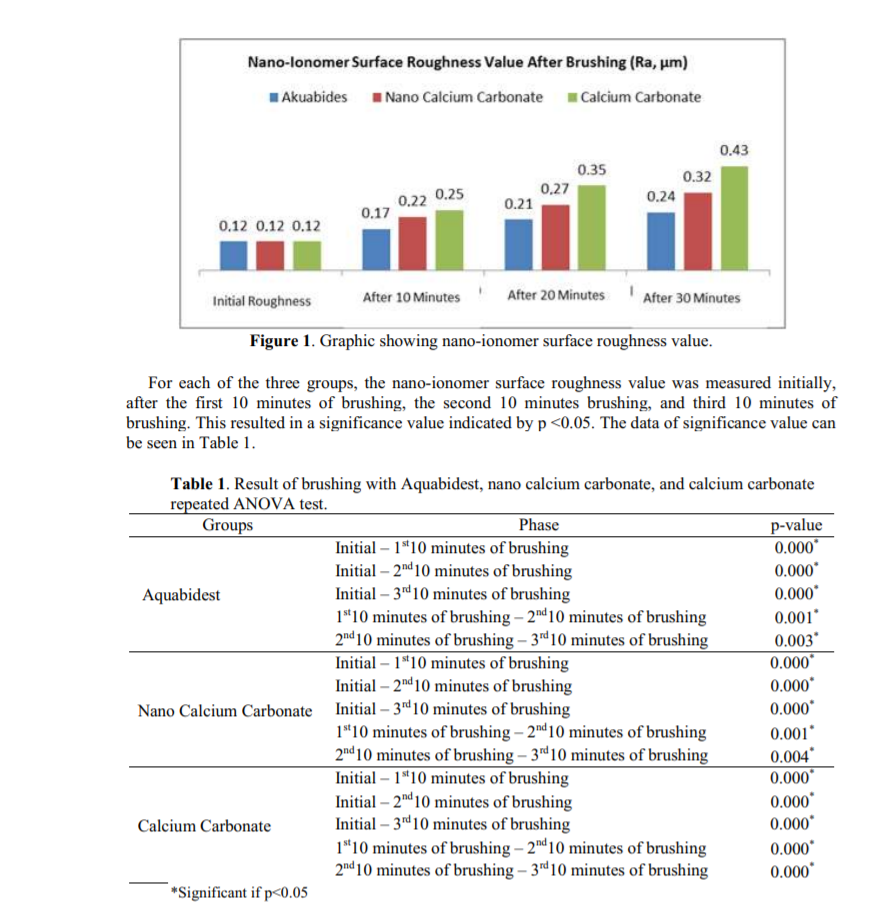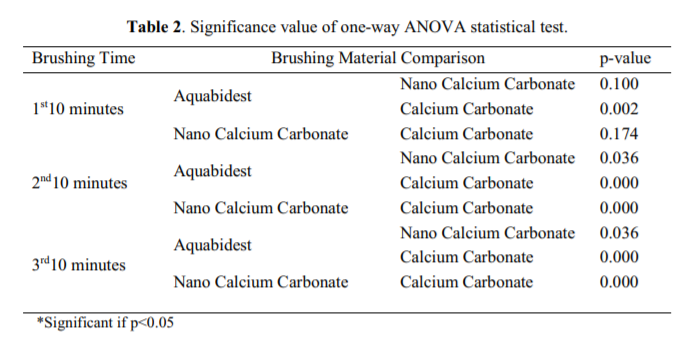The effect of brushing with nano calcium carbonate and calcium carbonate toothpaste on the surface roughness of nano-ionomer
Related content The effect of brushing with toothpaste containing nano calcium carbonate upon nanofill composite resin surface roughness A M Ramadhani, E Herda and S Triaminingsih - Surface changes of enamel after brushing with charcoal toothpaste U I Pertiwi, Y K Eriwati and B Irawan - Synthesis of Calcite Nano Particles from Natural Limestone assisted with Ultrasonic Technique M Handayani, E Sulistiyono, F Firdiyono et al.
To cite this article: D H Anisja et al 2017 J. Phys.: Conf. Ser. 884 012058
Related content The effect of brushing with toothpaste containing nano calcium carbonate upon nanofill composite resin surface roughness A M Ramadhani, E Herda and S Triaminingsih - Surface changes of enamel after brushing with charcoal toothpaste U I Pertiwi, Y K Eriwati and B Irawan - Synthesis of Calcite Nano Particles from Natural Limestone assisted with Ultrasonic Technique M Handayani, E Sulistiyono, F Firdiyono et al.
D H Anisja, D J Indrani and E Herda* Department of Dental Materials, Faculty of Dentistry, Universitas Indonesia, Jakarta, Indonesia * E-mail: ellyza_herda@yahoo.com
Abstract.
Nanotechnology developments in dentistry have resulted in the development of nano-ionomer, a new restorative material. The surface roughness of restorative materials can increase bacteria adhesion and lead to poor oral hygiene. Abrasive agents in toothpaste can alter tooth and restorative material surfaces. The aim of this study is to identify the effect of brushing with nano calcium carbonate, and calcium carbonate toothpaste on surface roughness of nano-ionomer. Eighteen nano-ionomer specimens were brushed with Aquabidest (doubledistilled water), nano calcium carbonate and calcium carbonate toothpaste. Brushing lasted 30 minutes, and the roughness value (Ra) was measured after each 10 minute segment using a surface roughness tester. The data was analyzed using repeated ANOVA and one-way ANOVA test. The value of nano-ionomer surface roughness increased significantly (p<0.05) after 20 minutes of brushing with the nano calcium carbonate toothpaste. Brushing with calcium carbonate toothpaste leaves nano-ionomer surfaces more rugged than brushing with nano calcium carbonate toothpaste.
1. Introduction
Nanotechnology in dentistry has led to several restorative materials innovations. One innovation is the production of nano glass ionomer cement, known as nano-ionomer. This material combines resinmodified glass ionomer cement with nano filler technology [1,2]. Nano-ionomer have nano sized filler particles that affect material strength, optical properties, abrasion resistance, and improved aesthetic properties [2]. Previous research suggests surface roughness is one of the essential restoration properties. Dental restorative materials should last in oral cavity [3]. The purpose of restorative procedures is to provide a patient with an acceptable dental appearance by using smooth, nonporous restorative materials [4]. The abrasive materials in toothpaste can affect the surface roughness of the tooth and the restorative materials. The larger the particle sizes of the abrasive, the greater the abrasive nature of the toothpaste [5]. There are various types of toothpastes on the market, such as toothpaste for caries prevention, whitening, and sensitive teeth. Some toothpaste contains nano calcium carbonate. Calcium carbonate particle size is typically quite large compared to particles of nano calcium carbonate, ranging from 1 to 12μm [1,6]. Brushing with toothpaste containing abrasive materials can erode tooth surfaces and restorative materials [4] Surface roughness has been widely researched. Fitri (2012) studied the effect of brushing with toothpaste containing calcium carbonate on the surface roughness of resin-modified glass ionomer cement and nano-ionomer. In her study, the roughness value was higher in resinmodified glass ionomer cement compared with nano-ionomer [7]. Alviani (2014) studied the effect of brushing with nano calcium carbonate toothpaste and calcium carbonate toothpaste on nanofill composite resin restorative material. It resulted in a higher surface roughness value on nanofill composite resin brushed with calcium carbonate toothpaste than nano calcium carbonate toothpaste [8]. In general, toothpastes contain abrasive material to remove plaque and stains on a tooth’s surface. However, abrasive materials can also erode the matrices of restorative material surface, exposing the filler to the surface [9,10]. Therefore, this study focused on the effect of brushing with nano calcium carbonate toothpaste on surface roughness of nano-ionomer.
2. Materials and Methods
Eighteen nano-ionomer specimens were prepared in a cylindrical metal mold with a diameter of 6mm and a height of 3mm. The nano-ionomer KetacTM N100 was discharged from the tube, placed on paper pad, manipulated with a spatula, and condensed into a cylindrical mold. The top surface of the compacted nano-ionomer was smoothed with glass plate, layered with a mylar strip, and loaded with a 1kg weight on the glass plate. The specimens were light cured using Elipar light curing unit (3M ESPE) with 800mW/cm2 irradiance with the tip of the light curing unit perpendicular on the top of the mylar strip surface. The irradiation was carried out according to the nano-ionomer (KetacTM N100) factory instructions for 20 seconds, incrementally. The specimens were removed from the molds, and were immersed in a plastic pot containing Aquabidest. The specimens were stored in an incubator at 37°C for 24 hours [11]. The initial roughness of the specimens was measured using a Mituyoto SJ 301 surface roughness tester. The specimens were divided into three treatment groups, with six specimens per group. The first group was brushed with Aquabidest, the second group with nano calcium carbonate toothpaste, and the third group with calcium carbonate toothpaste. The toothpastes were diluted to a ratio of 1:1 (1gr toothpaste: 1ml Aquabidest) prior to application. The surface of each specimen was brushed in a circular motion for 10-minute and repeated 3 times. A 175gr load was used with an electric toothbrush. After brushing was completed, the specimen was rinsed with water and dried. Once dried, the surface roughness of the specimens were measured again. This was repeated until the last10- minute brushing was completed. The Data obtained were analyzed using repeated ANOVA test with post hoc Bonferroni to know the difference in the nano ionomer surface roughness value before and after treatments. The one-way ANOVA comparative test with the Bonferroni post hoc test was used to determine the difference in nano-ionomer surface roughness values between the three treatment groups.
3. Results and Discussion
3.1 Results
The results were obtained after brushing the nano-ionomer surfaces with Aquabidest, nano calcium carbonate toothpaste, and calcium carbonate toothpaste. There was an increase in surface roughness value after brushing for the first 10 minutes, the second 10 minutes, and the third 10 minutes, as shown in Figure 1.

This study also used the one-way ANOVA comparative test to compare nano-ionomer surface roughness values among three treatment groups after brushing with Aquabidest, nano calcium carbonate toothpaste, and calcium carbonate toothpaste. In the first 10minutes of brushing, there was a significant difference between the brushing using the aquabidest and the calcium carbonate toothpaste, as indicated by the significance value of p

3.2 Discussion
Brushing only with Aquabidest in the first 10 minutes was significantly different than brushing with calcium carbonate toothpaste. Significant differences between the abrasive materials appear in the second and third phases of brushing. A significant increase of surface roughness in the second brushing was assumed equivalent to two months of brushing. When comparing the two toothpastes, the surface roughness differences were significant after the nano-ionomers were brushed for 20 minutes. Increased surface roughness values with Aquabidest group occurred due to friction between the nano-ionomer surface and the electric toothbrush’s bristles. Various studies have shown that abrasions might be caused by several factors including brushing technique, force, duration, and frequency, as well as brush stiffness and type. It was decribed that the more rigid the bristles, the greater the surface abrasion on the nano-ionomer [4,12]. The surface roughness value of the nanoionomer surfaces brushed with calcium carbonate toothpaste was higher than with nano calcium carbonate toothpaste. Nano calcium carbonate toothpastes have particles sizes from 0.005-0.025μm, unlike calcium carbonate toothpastes, which have larger particles size from 1-12μm. The particle size of an abrasive materials affects its abrasion-rate, thus, the particles on the calcium carbonate toothpaste erode more of the nano-ionomer surface than the nano calcium carbonate toothpaste, or brushing without toothpaste [4,12,13]. Surface roughness greatly affects the aesthetics and longevity of a restorative material. A rough surface on the restorative material can accumulate plaque, altering the restoration color, and leading to gingival inflammation. This can degrade the aesthetic quality of restorative materials [1,14]. Bollen (1996) stated that the surface roughness (Ra) threshold value for bacterial adhesion is 0.2μm. Surface roughness of more than 0.2μm has the potential for plaque and bacterial accumulation, as well as the possibility of periodontal disease, and secondary caries [1,15]. In this research, we found the nanoionomer surface roughness value when brushed using Aquabidest was still within safety limit after brushing for 10 minutes(0.17μm), but exceeded the safety limit after brushing for 20 minutes and 30 minutes (0.21μm and 0.24μm, respectively). In addition, the use of nano calcium carbonate toothpaste has also been shown to improve remineralization in the oral cavity, preventing early caries lesion since it binds sodium fluoride [6,10,16].
4. Conclusion
Brushing with calcium carbonate toothpastes results in greater nano-ionomer surface roughness than brushing with nano calcium carbonate toothpaste.
Tan Ky Mineral offer a range of natural calcium carbonate with adjustable abrasivity levels, that suits the needs of modern toothpaste formulations - A pure and natural ingredient providing multifunctional benefits. Calcium carbonate is manufactured using clean and controlled sustainable production and conditions that benefit from a low carbon footprint. (purity 99%-whiteness98%min)
Please check product specification as link:



